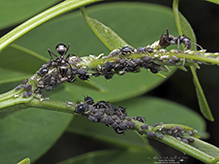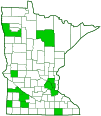black bean aphid
(Aphis fabae)
Conservation • Description • Habitat • Ecology • Distribution • Taxonomy
|
|
||||||||||||||
Description |
Black bean aphid is a common, exotic, small aphid. It is native to Europe and Asia, and it has been widely introduced elsewhere. It now occurs in the temperate regions of the world, including in Europe, Asia, the Middle East, Africa, Australia, North America, and South America. The first North American record was in New York state in 1870. Black bean aphid feeds on a very wide variety of plants. It has been recorded on almost 300 species of plants in almost 120 plant families. It is an economically important pest of many agricultural crops, including beans, beets, cruciferous vegetables, cucurbits, peas, potatoes, sunflower, tobacco, tomato, and tulip. It causes direct feeding damage to the plant, it reduces the number of seeds produced, and it transmits more than 40 plant viruses. The primary host, where aphids reproduce sexually and eggs overwinter, are shrubs in the genera Euonymus and viburnum. The secondary hosts, where aphids reproduce asexually, include more than 200 herbaceous species of wild and cultivated plants. Unwinged female adults (apterae) are 1⁄32″to ⅛″ (1.2 to 2.9 mm) in length. The body is soft, broadly oval, and dull dark brown to matte black (dark). It sometimes has a distinct greenish hue. The head and the upper plate on the first segment of the thorax (pronotum) are not fused. The antennae have 6 segments, and they are shorter than the body. The third and fourth segment, and the base of the fifth segment, are usually pale. The remaining segments are dark. There are two conspicuous compound eyes with many facets. On top of the head there are three simple eyes (ocelli) in a broad triangle. On the rear side margin of each compound eye there is another small eye (triommatidium) with just three facets. The beak-like projection of mouthparts (rostrum) is relatively long. It has five segments, but segments 4 and 5 are fused together, making it appear to have only four segments. On each abdominal segment, including segments 1 and 7, there is a small, rounded bump near each lateral margin (marginal tubercles). The marginal tubercles are small, and they are sometimes difficult to distinguish from breathing pores (spiracles). There is a pair of elongated processes (cornicles) near the end of the abdomen. The cornicles are small, stump-like, and pale. The tail-like appendage (cauda) is short and is distinctly constricted near the base. The cornicles and the cauda are dark. The legs are black and pale. Immature winged females (alates) have two distinct, waxy, white spots on abdominal segments 1 through 5. Adult alates sometimes also have these spots, but they are otherwise similar to adult apterae. On the forewings, the median vein is forked twice, and three of the branches reach the wing margin. veins Cu1 and Cu2 are present. |
Size |
Total length: 1⁄32″to ⅛″ (1.2 to 2.9 mm) |
Similar Species |
Habitat and Hosts |
Primary hosts: Euonymus spp. and viburnum spp. shrubs Secondary hoists: more than 200 species of herbaceous plants |
Ecology |
Season |
|
Behavior |
On alates, the wings are held vertically or roof-like over the body when at rest, never flat over the body. |
Life Cycle |
Sexual forms occur in fall. They lay their eggs on Euonymus spp. and viburnum spp. The eggs overwinter. |
Food |
Plant juices |
Distribution |
||
|
Sources |
|
| 1/23/2025 | ||
Occurrence |
||
Common and widespread |
||
Taxonomy |
|
Order |
Hemiptera (True bugs, Hoppers, Aphids, and Allies) |
Suborder |
Sternorrhyncha (plant-parasitic hemipterans) |
Infraorder |
Aphidomorpha (aphids and allies) |
Superfamily |
Aphidoidea |
Family |
Aphididae (aphids) |
Subfamily |
Aphidinae |
Tribe |
Aphidini |
Subtribe |
Aphidina |
Genus |
Aphis |
Subordinate Taxa |
|
black bean aphid (Aphis fabae cirsiiacanthoidis) black bean aphid (Aphis fabae evonymi) black bean aphid (Aphis fabae fabae) black bean aphid (Aphis fabae mordvilkoi) |
|
The former subspecies Aphis fabae solanella has been raised to full species status as Aphis solanella. Some authors treat the subspecies Aphis fabae evonymi as the full species Aphis evonymi. |
|
Synonyms |
|
Aphis aparines Aphis apii Aphis apocyni Aphis cirsiiacanthoides Aphis nerii Aphis philadelphi Aphis rumicis papaveris |
|
Common Names |
|
bean aphid black bean aphid |
|
Glossary
Ocellus
Simple eye; an eye with a single lens. Plural: ocelli.
Pronotum
The exoskeletal plate on the upper side of the first segment of the thorax of an insect.
Rostrum
The stiff, beak-like projection of the carapace or prolongation of the head of an insect, crustacean, or cetacean.
Spiracle
A small opening on the surface of an insect or arachnid through which it breathes.
Tergite
The upper (dorsal), hardened plate on a segment of the thorax or abdomen of an arthropod or myriapod.
Tubercle
On plants and animals: a small, rounded, raised projection on the surface. On insects and spiders: a low, small, usually rounded, knob-like projection. On slugs: raised areas of skin between grooves covering the body.
Visitor Photos |
||
Share your photo of this insect. |
||
This button not working for you? |
||
Alfredo Colon |
 |
MinnesotaSeasons.com Photos |
||
|
||
|
||

Visitor Videos |
||
Share your video of this insect. |
||
This button not working for you? |
||
|
Other Videos |
||
M𝐨𝐯𝐞𝐦𝐞𝐧𝐭 𝐨𝐟 𝐛𝐥𝐚𝐜𝐤 𝐛𝐞𝐚𝐧 𝐚𝐩𝐡𝐢𝐝 (𝐀𝐩𝐡𝐢𝐬 𝐟𝐚𝐛𝐚𝐞) 𝐨𝐧 𝐟𝐥𝐨𝐰𝐞𝐫 𝐬𝐭𝐞𝐦... |
About
Jan 5, 2024 The black bean aphid (Aphis fabae) is a small black insect in the genus Aphis, with a broad, soft body, a member of the order Hemiptera. Other common names include blackfly, bean aphid, and beet leaf aphid. it is found in large numbers on the undersides of leaves and on the growing tips of host plants.They suck sap from stems and leaves and cause distortion of the shoots, stunted plants, reduced yield, and spoiled crops. This aphid also acts as a vector for viruses that cause plant disease, and the honeydew it secretes may encourage the growth of sooty mould. |
Ants and Aphids: Origins of Animal Husbandry |
About
Jun 26, 2017 Small ants tend their flocks of Black Bean Aphids (Aphis fabae) while aphids sip sap (and excrete honeydew) from the terminal stem of a Burdock plant (Arctium lappa). Filmed at the Turtle River State Park, Arvilla, North Dakota (25 June 2017). |
Black bean aphid - Aphis fabae - on Burdock - velcro plant - Krókalappa |
About
Nov 23, 2017 Black bean aphid - Aphis fabae - Blackfly - Blaðlús - Also known as Blackfly - Wingless aphids feeding on a stem - Small black insect on my plant. These mate and the females lay eggs which overwinter. On Burdock - Arctium lappa - Cocklebur - krókakollur - Krókalappa - villijurt. Best to handle Burdock with gloves when working with the burrs and seeds. Burdock is a biennial plant. The first year the plant is identified by it’s basal leaves, sometimes getting enormous in size. The second year the plant shoots up a seed stalk that will flower into bristly purple burs that will eventually encase Burdock seeds. The Lesser Burdock is a biennial, its purple flowers showing in its second year of growth. |

|
Created: 1/23/2025 Last Updated: © MinnesotaSeasons.com. All rights reserved. |




